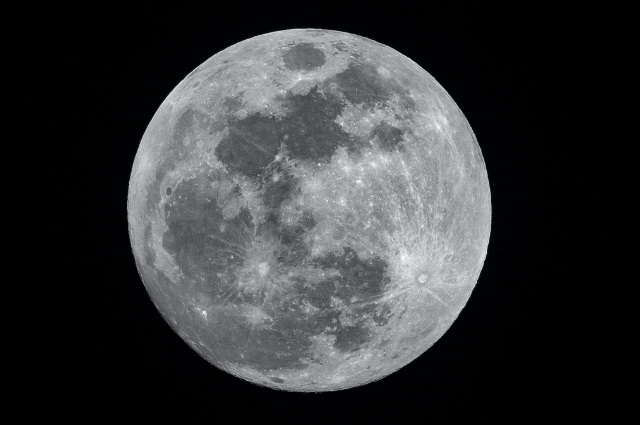
Photo by Mike Petrucci on Unsplash
While initial forays have allowed us to tread upon Moon’s desolate surface, the endeavor to establish a lasting human presence necessitates a comprehensive assessment of present and future opportunities. Through an examination of cutting-edge technologies, pioneering conceptual frameworks, and potential advancements, this exegesis provides an all-encompassing panorama of the intricate interplay of factors that can propel humanity towards the realization of extraterrestrial habitation.
1. Lunar Resource Utilization:
Advancements in drilling and excavation technologies enable the extraction of water ice from the lunar polar regions. Water ice, a critical resource, can be utilized for life support systems, propellant production, and radiation shielding. The extraction process involves innovative thermal and mechanical techniques, optimizing resource acquisition while minimizing energy requirements. Integrated mining and refining techniques, synergistically coupled with the astute deployment of in-situ resource utilization (ISRU) methodologies, serve as the bedrock for the establishment of vital life support systems, manufacturing capabilities, and fuel production. Regolith processing techniques involve high-temperature sintering, electrolysis, and advanced separation methods to extract oxygen, metals, and construction materials. These resources can be utilized for habitat construction, infrastructure development, and future manufacturing industries on the Moon. Exploration for rare minerals on the Moon holds tremendous economic potential. Advanced spectroscopic techniques, remote sensing technologies, and robotic prospectors enable the identification and mapping of mineral deposits. The utilization of rare minerals can catalyze the development of advanced technologies, including high-performance electronics, energy storage systems, and sustainable manufacturing processes.
2. Advanced Robotics and Automation:
The development of highly capable lunar rovers and exploration robots is essential for comprehensive lunar surface exploration. These robotic systems leverage advanced locomotion mechanisms, computer vision algorithms, and autonomous decision-making capabilities to navigate the challenging lunar terrain, collect samples, and conduct scientific experiments. They are remotely operated or operate autonomously using AI-based algorithms. Deploying autonomous construction systems on the Moon enables rapid and efficient habitat and infrastructure development. These systems incorporate advanced robotics, machine learning algorithms, and multi-agent coordination techniques to perform tasks such as excavation, material handling, and construction assembly. They optimize resource utilization, reduce human involvement, and enhance construction speed and precision. Integrating artificial intelligence (AI) into lunar infrastructure management allows for optimized resource allocation, predictive maintenance, and fault detection. AI algorithms analyze sensor data, monitor structural integrity, and predict potential failures. By employing machine learning and data-driven decision-making processes, AI-driven infrastructure management enhances operational efficiency, reduces maintenance costs, and ensures the sustainability of lunar habitats and facilities.
3. Sustainable Energy Solutions:
The conundrum of energy availability assumes paramount importance in the context of lunar colonization. Advanced photovoltaic technologies, such as thin-film solar cells and multi-junction solar cells, maximize energy conversion efficiency and durability in the lunar environment. Additionally, concentrator photovoltaics, utilizing mirrors or lenses, concentrate sunlight onto small, highly efficient solar cells, further optimizing energy generation. Storing and managing energy during lunar nights pose significant challenges. Advanced battery technologies, such as lithium-ion and solid-state batteries, store excess solar energy generated during the day for use during lunar nights. Regenerative fuel cells, utilizing oxygen derived from lunar resources, convert stored hydrogen into electrical energy, ensuring continuous power availability during extended periods of darkness. Exploring alternative energy sources on the Moon can enhance energy sustainability. Lunar surface nuclear power, utilizing small-scale fission reactors, has the potential to provide abundant and continuous energy for lunar bases and industrial operations. Additionally, leveraging the extreme cold temperatures of lunar cold traps enables cryogenic energy storage, utilizing liquefied gases to store and release energy efficiently.
4. Inflatable Habitats and Lunar Architecture:
Designing habitats that are lightweight yet durable is essential for lunar living. Inflatable habitats, constructed from advanced composite materials, offer low-mass solutions for lunar habitation. These habitats provide radiation shielding, thermal insulation, and structural integrity while maximizing interior space and minimizing launch mass. Utilizing lunar regolith as a construction material through 3D printing revolutionizes lunar architecture. Additive manufacturing techniques, employing lunar regolith as feedstock, enable on-site construction of habitat modules, infrastructure components, and even spare parts. 3D printing reduces the dependency on Earth for construction materials, optimizes resource utilization, and facilitates rapid and customizable construction processes. Designing modular habitats allows for expandability and adaptability to evolving needs. Modular systems enable easy transportation, assembly, and reconfiguration of habitat modules. Expandable architecture, utilizing inflatable or deployable structures, provides additional living and working space, accommodating an increasing lunar population and evolving mission requirements.
5. Life Support Systems and Closed-loop Environments:
Closed-loop systems minimize resource wastage by recycling and regenerating resources within a self-contained lunar environment. Water, air, and waste management systems employ advanced filtration, purification, and recycling technologies to ensure sustainable resource utilization. This closed-loop approach reduces dependency on resupply from Earth and ensures long-term autonomy. Bioregenerative life support systems integrate biological components, such as hydroponics and algae bioreactors, into the life support infrastructure. These systems enable the cultivation of plants, algae, and microorganisms to produce food, oxygen, and water regeneration through photosynthesis and nutrient recycling. Bioregenerative systems create self-sustaining ecosystems, reducing the need for continuous resupply and enhancing long-duration lunar missions. Maintaining psychological well-being is vital for lunar inhabitants. Virtual reality technologies simulate Earth-like environments, providing psychological relief and mitigating feelings of isolation and confinement. Interactive interfaces and communication tools enable real-time interactions with Earth, facilitating social connections and emotional support. Lunar habitats incorporate recreational areas, exercise facilities, and private spaces to ensure psychological comfort and balance. Maintaining a pristine lunar environment and implementing effective waste management systems are crucial for sustainable lunar colonization. Advanced environmental control systems regulate temperature, humidity, and air quality within lunar habitats, ensuring optimal living conditions for inhabitants. Innovative waste management technologies, such as microbial bioreactors and advanced recycling systems, allow for the efficient conversion of waste into valuable resources, reducing the need for resupply missions from Earth and minimizing the accumulation of waste on the lunar surface.

6. Lunar Communication and Navigation:
Establishing advanced communication systems between Earth and the Moon enables efficient data transmission and teleoperation. High-bandwidth laser communication systems offer significantly faster data transfer rates compared to traditional radio frequency systems. Next-generation radio frequency technologies, including advanced modulation schemes and adaptive beamforming, enhance communication reliability and bandwidth efficiency. Deploying lunar satellites and implementing autonomous navigation algorithms enable precise positioning and navigation on the Moon's surface. Lunar satellite constellations provide coverage for navigation, communication, and scientific measurements. Autonomous navigation algorithms combine visual odometry, Simultaneous Localization and Mapping (SLAM), and terrain analysis to enable safe and accurate movement planning for rovers and human explorers on the lunar surface.
7. Human Health and Performance:
Advancements in space medicine mitigate the physiological effects of long-duration spaceflight on lunar inhabitants. Studies on bone loss, muscle atrophy, and cardiovascular health inform the development of countermeasures such as exercise regimes, medication, and dietary interventions. Biomedical research on genetic expression, immunology, and regenerative medicine aims to enhance the resilience and health of lunar settlers. Mitigating the adverse effects of microgravity on the human body is a significant consideration for lunar habitation. Concepts such as centrifuge-based habitats or rotating spacecraft create artificial gravity to simulate Earth's gravity, mitigating musculoskeletal and cardiovascular issues. Ongoing research focuses on optimizing artificial gravity parameters, such as rotation rates and habitat designs, to maximize the health benefits for lunar inhabitants. Deploying telemedicine technologies enables remote healthcare delivery and diagnostic support on the Moon. Real-time medical consultations, remote diagnostics, and teleoperation assistance connect lunar inhabitants with healthcare professionals on Earth. Robotic systems equipped with medical instruments can be remotely operated, allowing for surgical procedures and emergency medical interventions in lunar habitats.
8. Space Tourism and Commercial Ventures:
Private enterprises investing in lunar transportation capabilities open up possibilities for commercial lunar ventures. Lunar landers, reusable spacecraft, and cargo delivery systems facilitate transportation of resources, equipment, and personnel between Earth and the Moon. The development of cost-effective and reliable transportation services fuels the growth of lunar industries and commercial activities. Commercial ventures focused on resource extraction and utilization on the Moon offer economic opportunities. Mining operations for lunar resources, such as water, helium-3, and rare minerals, can support the growth of manufacturing industries and in-space propellant production. The utilization of lunar resources reduces the cost and dependency on Earth for supplies, fostering a self-sustaining lunar economy. The advent of lunar tourism provides unique experiences for space enthusiasts and explorers. Lunar tourism initiatives offer sightseeing trips, educational programs, and scientific excursions on the Moon. Educational opportunities, such as lunar research projects and workshops, promote scientific exploration and inspire the next generation of space scientists and engineers.

Photo by The New York Public Library on Unsplash
Conclusion:
This meticulously detailed analysis of present and future opportunities for lunar colonization reveals the intricate interplay of factors that shape the path towards extraterrestrial habitation. By leveraging lunar resource utilization, advanced robotics, sustainable energy solutions, innovative lunar architecture, closed-loop environments, robust life support systems, advanced communication and navigation, considerations for human health, and the growth of commercial ventures, humanity can pave the way for a sustainable and inspiring era of lunar colonization. The immense potential of the Moon awaits our exploration and endeavors, inviting us to transcend the boundaries of our home planet and embrace the challenges of living and thriving on the lunar frontier.
